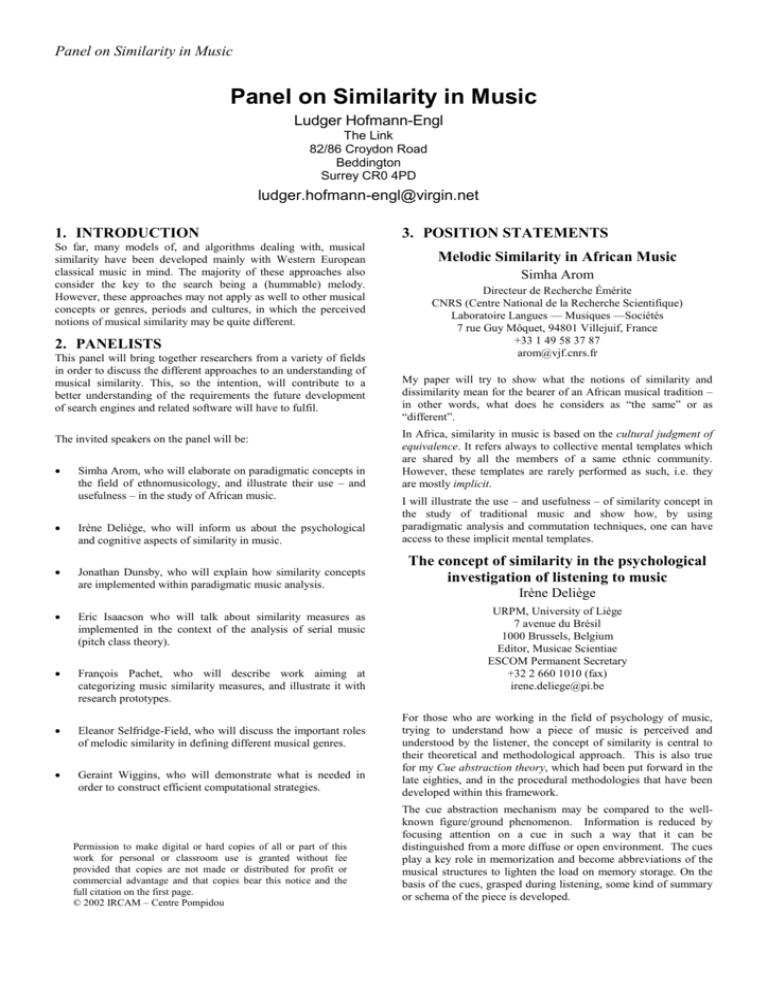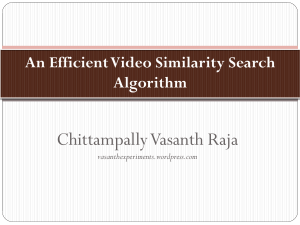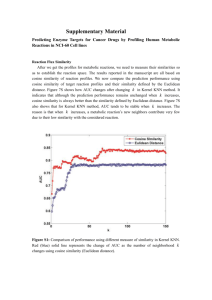ISMIR 2002 Panel on Similarity in Music
advertisement

Panel on Similarity in Music Panel on Similarity in Music Ludger Hofmann-Engl The Link 82/86 Croydon Road Beddington Surrey CR0 4PD ludger.hofmann-engl@virgin.net 1. INTRODUCTION So far, many models of, and algorithms dealing with, musical similarity have been developed mainly with Western European classical music in mind. The majority of these approaches also consider the key to the search being a (hummable) melody. However, these approaches may not apply as well to other musical concepts or genres, periods and cultures, in which the perceived notions of musical similarity may be quite different. 2. PANELISTS This panel will bring together researchers from a variety of fields in order to discuss the different approaches to an understanding of musical similarity. This, so the intention, will contribute to a better understanding of the requirements the future development of search engines and related software will have to fulfil. The invited speakers on the panel will be: Simha Arom, who will elaborate on paradigmatic concepts in the field of ethnomusicology, and illustrate their use – and usefulness – in the study of African music. Irène Deliège, who will inform us about the psychological and cognitive aspects of similarity in music. Jonathan Dunsby, who will explain how similarity concepts are implemented within paradigmatic music analysis. Eric Isaacson who will talk about similarity measures as implemented in the context of the analysis of serial music (pitch class theory). François Pachet, who will describe work aiming at categorizing music similarity measures, and illustrate it with research prototypes. Eleanor Selfridge-Field, who will discuss the important roles of melodic similarity in defining different musical genres. Geraint Wiggins, who will demonstrate what is needed in order to construct efficient computational strategies. Permission to make digital or hard copies of all or part of this work for personal or classroom use is granted without fee provided that copies are not made or distributed for profit or commercial advantage and that copies bear this notice and the full citation on the first page. © 2002 IRCAM – Centre Pompidou 3. POSITION STATEMENTS Melodic Similarity in African Music Simha Arom Directeur de Recherche Émérite CNRS (Centre National de la Recherche Scientifique) Laboratoire Langues — Musiques —Sociétés 7 rue Guy Môquet, 94801 Villejuif, France +33 1 49 58 37 87 arom@vjf.cnrs.fr My paper will try to show what the notions of similarity and dissimilarity mean for the bearer of an African musical tradition – in other words, what does he considers as “the same” or as “different”. In Africa, similarity in music is based on the cultural judgment of equivalence. It refers always to collective mental templates which are shared by all the members of a same ethnic community. However, these templates are rarely performed as such, i.e. they are mostly implicit. I will illustrate the use – and usefulness – of similarity concept in the study of traditional music and show how, by using paradigmatic analysis and commutation techniques, one can have access to these implicit mental templates. The concept of similarity in the psychological investigation of listening to music Irène Deliège URPM, University of Liège 7 avenue du Brésil 1000 Brussels, Belgium Editor, Musicae Scientiae ESCOM Permanent Secretary +32 2 660 1010 (fax) irene.deliege@pi.be For those who are working in the field of psychology of music, trying to understand how a piece of music is perceived and understood by the listener, the concept of similarity is central to their theoretical and methodological approach. This is also true for my Cue abstraction theory, which had been put forward in the late eighties, and in the procedural methodologies that have been developed within this framework. The cue abstraction mechanism may be compared to the wellknown figure/ground phenomenon. Information is reduced by focusing attention on a cue in such a way that it can be distinguished from a more diffuse or open environment. The cues play a key role in memorization and become abbreviations of the musical structures to lighten the load on memory storage. On the basis of the cues, grasped during listening, some kind of summary or schema of the piece is developed. Panel on Similarity in Music What might constitute a cue depends on the cultural and historical origin of the music. For example, as Western compositional techniques evolved, the importance of similarity increased just as did the use of motivic entities which fulfill the role of cues. Thus, motifs, whose identity was reinforced by repetitions or variations, appeared more and more in Western music during the fifteenth century. In more recent times - and in other cultures – many other types of musical elements may fulfill this role, but, the concept of a cues involves automatically that similarity perception comes into play. The contribution will show how similarity perception in the cue abstraction was considered in the psychological approaches, focusing on its implicit or explicit use by the listener. Paradigmatic Analysis of Melody: Dipping Your Hand in the Same River Twice Jonathan Dunsby Department of Music The University of Reading 35 Upper Redlands Road Reading RG1 5JE, UK +44 (0)118 931 8411 (fax: 8412) j.m.dunsby@reading.ac.uk Paradigmatic music analysis has a history going back centuries, as Umberto Eco clearly had in mind in the introduction to A Theory of Semiotics. In the mid-20th-century such analysis had burgeoned in the work of Rudolph Réti, where a strong structuralist impulse privileged the immanent relationships below the musical ‘surface’. Although Réti’s avowed commitment to the intuitive realities of musical perception has been acknowledged, much of his research has been generally dismissed as impressionistic, and certainly not scientifically reproducible. It will be proposed here that the epistemological system exposed above all by Jean-Jacques Nattiez is the site of actual progress in harnessing comparative, semiological analysis to a convincing picture of the place of such analysis in human musical and conceptual behaviour. Similarity in posttonal music Eric J. Isaacson Assoc. Prof. of Music Theory Indiana University School of Music 1201 East Third Street Bloomington, Indiana 47405, USA +01 812 855 0296 isaacso@indiana.edu The notion of structure in music is dependent that of similarity. In tonal music, similarity of harmony, tonality, melody, rhythm, and other musical characteristics inform our perception of musical structure. Similarities in these domains, while often understood implicitly, are nevertheless relatively well understood in tonal music compared to what we know about the role of similarity, and hence what we understand about structure, in posttonal music. In my presentation, I will briefly summarize the current state of research involving similarity in post-tonal (pre-serial) music, discuss current trends in this area, and describe what I believe to be the most important issues remaining. Music SimilaritieS François Pachet Sony Computer Science Laboratories 6, rue Amyot 75005 Paris, France +33 1 44 08 05 16 pachet@csl.sony.fr In the context of Electronic Music Distribution we are interested in extracting automatically similarity measures between music titles. Music title similarity is, however, as natural as it is illdefined. This paper highlights the many sources of similarity that are possible between titles taken as single entities, ranging from the trivial (two titles are similar because they are played by the same artist), the objective (two titles share the same musical features) to the metaphorical (La Marseillaise is similar to All You Need is Love by the Beatles because there is a musical quotation of the former in the latter). We show techniques to extract each class of musical similarity, and illustrate the results by examples and prototypes. Finally we raise the issue of aggregating these different sources of similarity to produce relevant similarity relations that can help users find interesting music in large, unknown catalogues. Why is the concept of melodic similarity so important in art music of the European tradition? Eleanor Selfridge-Field Consulting Professor (Music and Symbolic Systems) CCARH, Braun #129 Stanford University Stanford, CA 94305-3076, USA Tel. +1 (650) 725-9242 Fax: +1 (650) 725-9290 For those with in interesting in searches the repertories of European art music from antiquity through the end of the nineteenth century, the ability to identify melodic similarity is essential. There are two main obstacles to doing this: (1) the highly varied roles that “similarity” plays in defining different musical genres and (2) the absence of consensus as to how different kinds of similarity might be ranked against one another. This contribution takes up the first of these points. Melodic identity really is at the heart of the European/Western musical tradition. The problems come under various labels and the implications for several kinds of melodic relationships (drawn from paraphrase/ parody, chain procedures, canon/fugue, augmentation/diminution, variations, motivic development, Leitmotiven) will be briefly noted. Many of these phenomena have analogies in both Western popular (jazz) and non-Western art-music traditions. For researchers designing search strategies, an important question is whether universal algorithms can produce sufficiently useful results or whether(as has often been the case with notational software) the desired permutations will only be retrievable through dedicated program modules. Panel on Similarity in Music Horses for courses or How to choose an algorithm to do what you need Geraint A. Wiggins Centre for Computational Creativity City University, London Over the past few years, with the explosion of interest in music information retrieval, there has been a powerful research movement, studying computer systems which enable humans to find music on computers. This research has often been driven by the application of existing algorithms for the processing of particular kinds of data to music (mis)represented in one way or another in terms of that kind of data. This has led us to some conclusions which, in the cold light of day, may be questionable both from the point of view of computational efficiency, and also from that of psychological plausibility (if that is an issue). In this short presentation, I will consider methods for music matching based on string processing and edit-distance analysis, and argue that these approaches are at best approximate and at worst actively misleading, even when they are applied to the case where they are most appropriate: that of monodic music. I will then introduce SIA(M)ESE, a new method for pattern matching in multidimensional datasets (of which, I claim, music is an instance). I will argue that, while not quite as fast as some specialized string-based methods, SIA(M)ESE subsumes existing note-based music matching methods in monody and polyphony, while being more musically plausible than, and as computationally efficient as, many (though not all) of the algorithms it can replace. I am very grateful to my valued colleagues Dave Meredith and Kjell Lemström for their significant part in the development of the ideas presented here. 4. MODERATOR’S BIOGRAPHY The panel will be moderated by Ludger Hofmann-Engl. Hofmann-Engl works as a music teacher at The Link, a school for children with mild learning difficulties. He obtained his MA in music (Dahlhaus, de la Motte-Haber), philosophy and physics in Berlin in 1991, and his PhD on melodic similarity and melodic transformations (Keele University, John Sloboda) in 2002. He has been working in the field of melodic similarity for the last 10 years. He has given several talks on the same issue (e.g. University of Texas at Dallas, Lancaster University, City University London and King's College London). He has written the review on "Similarity concepts, procedures, and applications" (ed. Hewlett & Selfridge-Field) for MTO and he contributed to the last ISMIR with his paper "Towards a model of melodic similarity". His paper on rhythmic similarity was read by Richard Parncutt during ICMCP7 (2002). He will present a poster on the issue of melodic similarity during ICMAI02 in Edinburgh. Further publications are in preparation. Hofmann-Engl has been active as a composer for the last 20 years. His music has been performed, recorded on CD and broadcast many times. His interest in melodic similarity is driven by the wish to establish functional compositional tools..







